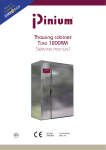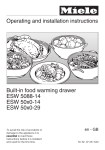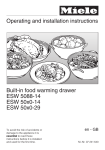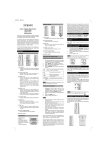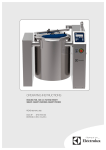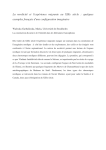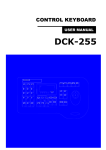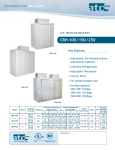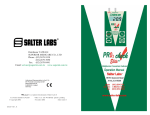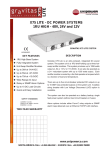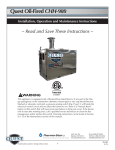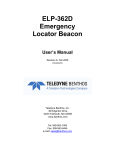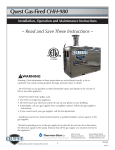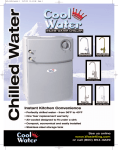Download Thawing cabinet Tina 1200U Operating Instructions
Transcript
in y e d nb a M de e Sw Thawing cabinet Tina 1200U Operating Instructions ContentsPage General product description 3-4 Control panel 5 Starting of thawing process 6 Thawing process step by step 7 Tips and advises 8 Cleaning and maintenance 9 Deliming of steam generator 10 Alarm conditions 11 DOC.NO EDITION 1 1 STO 9190-02 2014.10 Producer: SteelTech i Alingsås AB. Lärkvägen 4. SE-441 40 Alingsås. Sweden Phone: +46 322 668930 . Fax: +46 322 10870 E-mail: [email protected] .www steeltech.se 2 General product description These operating instructions apply to the Thawing cabinet Tina 1200U. General instructions • The safety of the product can be jeopardize and the supplier’s warranty and product responsibility invalid if the directives in the equipment and other documentation are not followed. • Study the instructions in this document carefully as they contain important information regarding installation, operating safety, use and maintenance of the product. Keep the document available to all users. • All service, maintenance and repairs must be carried out by a trained technician. Only genuine Please notice! Only use the specially designed baskets or perforated containers available as accessories. If the wrong kinds of baskets/perforated containers are used the result may be completely different to the one intended. The wire basket is designed for larger pieces of produce such as; steaks, fillets of meat and fish etc. The perforated container is designed for smaller pieces of produce such as prawns, berries, diced and sliced meat etc. spare parts may be used for replacement. Refer to the Service instructions* and the Spare part catalogue*. • Operating and maintenance of this product have to be carried out by trained personnel. * Not supplied. Can be ordered from the supplier or the supplier’s representative. Tina1200U is manufactured in accordance with the directives, LVD2006/95/EG, EMC 2004/108/EG and is CE marked. Application area Safety instructions The thawing cabinet is intended for thawing of different kinds of produce, it may under no circumstances be used in any other way or for any other purpose than described in these operating instructions. Using the Tina 1200U you can thaw different kinds of produce in a lenient process. this means that the produce will always keep their succulence and retains the quality of the produce, and the weight reduction will be minimal. The cabinets are easy to keep clean and rational to work with and all significant components are manufactured of stainless steel. The cabinet can be used as refrigerator during a limited period of time ( max. 4 days). Switch off the power before faults or breakdowns are rectified. • Set the Selector switch on 0. • Wait approximately 3 minutes to give the electrical cooling valve time to close completely. • Switch off the Main circuit breaker (Not on the cabinet). Maximum food weight per thawing occasion: Tina 1200U 150 kilos Tina 1200 can be used with a GN 2/1 rack trolley that holds 13 GN 2/1 baskets/containers or 2pcs. GN 1/1 rack trolleys that holds 13 GN 1/1 baskets/containers each. 3 CE-directive Warning! Electricity! The warning sign identifies the electrical control unit of the machine. Doors to electrical cabinets as well as other cover plates may only be opened by a suitably trained technician. Warning! • The thawing cabinet may not be flushed or cleaned in the corresponding way exteriorly. • Water coming into contact with live components results in direct mortal danger. Always exercise care when cleaning, especially close to electrical connections. • Use a dampened cloth when cleaning. Warning! Note that the walls inside the cabinet can become extremely hot during the bactericidal/cleaning process and could cause injury if touched. Be careful when opening the cabinet door. Hot currents of escaping air could result in burns. Technical data Rating plate. Rating plates stating the machine’s serial number are attached at the bottom of the thawing cabinet’s left side and the rear of the electrical cabinet, as well as on the EU declaration which accompanies the machine on delivery. Noise level: < 70 dB Water protection class: IP X4 Operator information Before starting work the operator should: • Obtain good knowledge in handling and care. • Localize each warning sign and understand its purpose. • Carefully read through the safety instructions and warning texts. • Read the General instructions. Cleaning Cleaning agent The cabinet should always be cleaned after use. There are cleaning agents available on the market for cleaning equipment used in large kitchen. Follow the manufacturer’s instructions carefully and observe prescribed safety recommendations. Cleaning the casing • Clean the external stainless surfaces using warm water, combined with a neutral detergent/cleaning agent and a soft brush or sponge if necessary. • Panels and knobs are wiped with damp cloth. Cleaning the inside See instructions on page 9. NOTE! Do not use wire wool or abrasive agents on the stainless steel surfaces. Do not use cleaning agents containing chlorine. Chlorine and chlorine compounds that come into contact with stainless steel can result in corrosion. Follow the instructions below when the cabinet is not used for long periods • Set the Selector switch on 0. • Wait approximately 3 minutes to give the electrical cooling valve time to close completely. • Switch off the Main circuit breaker (Not on the cabinet). • Clean the cabinet inside and out, as well as its removable parts. See Cleaning. • Switch off the water supply • Open the door so that air can circulate in order to prevent mould and bad odors developing in the closed space. Supplementary equipment and accessories • Rack trolley GN2/1 • Rack trolley GN1/1 • Guide rail for trolley GN2/1 • Guide rail for trolley GN1/1 • Basket GN 2/1 • Basket GN1/1 • Perforated container GN 2/1 • Perforated container GN 1/1 Other documentation Manufacturer’s declaration Installation instructions Service instructions* Spare parts catalogue* * Not supplied. Can be ordered from the supplier or the supplier’s representative. 4 Control panel 1= THAWING Turn the Selector switch to 1. The steam generator is then emptied of water and refilled with fresh new water. The refrigeration compressor and the fans now start to decrease the cabinet temperature to 36ºF (+2ºC). The cabinet is now ready to use. Note! The Selector switch should be allowed to stand for at least 3 min. in one position before being changed to the other. = DISINFECTING/CLEANING Turn the Selector switch to The bactericidal/cleaning process starts with low temperature steam spreading throughout the Tina cabinet. The temperature increases to 176ºF (+80ºC), this procedure takes approximately 30 minutes. When the cabinet temperature is at 176ºF (+80ºC) a five minute bactericidal/cleaning cycle begins. After five minutes a buzzer sounds and the indication Er4 flashes on the right hand side display (the display that indicates the cabinet temperature). The buzzer will sound and Er4 will flash until the cabinet temperature has decreased to 104ºF (+40ºC), or below, or until the button PRG/mute on the right hand side display is pressed. If the cabinet is to be used immediately after the disinfecting/cleaning open the door and let the cabinet temperature decrease to 104ºF (+40ºC). Thereafter turn the Selector switch to 1. If the cabinet is not to be used immediately turn it to 0. DISPLAY THAT INDICATES THE CABINET TEMPERATURE. Please observe that the buttons on this display are blocked and are only to be used by service and maintenance personnel. DISPLAY FOR SETTING OF THE TARGET TEMPERATURE. This display is used for setting the target temperature (required value) and it indicates the surface temperature ( actual value) of the produce. 5 Starting of the thawing process Put the produce in the baskets/containers that are specially designed for the Tina cabinet. Place the baskets into the rack trolley. Put the rack trolley into the cabinet. SETTING OF TARGET TEMPERATURE (REQUIRED VALUE) Set the required target temperature somewhere between the interval of 30ºF (–1ºC) and 36ºF (+2ºC). Please notice that the target temperature of the cabinet is factory preset at 34ºF (1ºC) as this is the recommended target temperature in most cases. See table of recommended temperatures on page 7. Press the button SEL and keep it pressed for two seconds. The display will then show the last set target temperature. To change the setting press one of the buttons labeled with an arrow: = Increase temperature, = decrease temperature When the required target temperature is set press the button labeled SEL twice. APERTURE FOR SURFACE PROBE The surface probe controls the thawing process. To be able to insert it into the frozen produce one has to make an aperture with the help of the enclosed specially designed drilling tool. The depth of the aperture must be equivalent to the threads on the drilling tool and should be made in the thickest part of the produce. Note! To obtain direct contact between the temperature probe and the produce, it is necessary to make a opening in the plastic package when using plastic pre-packed produce. PLACEMENT OF THE SURFACE PROBE/STARTING OF THE THAWING PROCESS Insert the needle of the probe into the aperture and press it down gently to fixating and making sure that the probe is correctly in place. As the surface probe swiftly feels the temperature of the frozen produce and as the temperature of the produce is much below the preset target temperature the thawing process will start automatically. Close the door. 6 The thawing process step-by-step The temperature increases step by step to approximately 60ºF (+15ºC), this will take approximately 15 minutes. The Tina cabinet will maintain this temperature until the Surface temp. (actual value) of the produce is 6ºF (3ºC) less than Target temp. ( required value). Then the cabinet temperature will reduce to 45ºF (+7ºC), the cabinet temperature can be seen on the display during the whole process. When the temperature of the produce equals the set target temperature and it has stayed stable for five minutes the cabinet automatically switches from thawing mode to refrigeration mode and the cabinet temperature will decrease to 36ºF (+2ºC). The thawed produce can now be stored cold in the cabinet, just as in a refrigerator, until it is to be used. Restart the thawing process by refilling the baskets/containers and repeat the procedure previously described. See page 6 Target temperatures and thawing times Produce Tenderloin Target temperature ºF (C) 34(+1.0) Approx. thawing time Hour(s) 3.5 Rump-steak piece 35(+1.5) 8 Pork neck 35(+1.5) 6 Diced beef 34(+1.0) 5.5 Fillet of veal 34(+1.0) 3 Fillet of chicken 34(+1.0) 2.5 Chicken, whole, 1 kilo/piece 35(+1.5) 6 Fillet of Codfish, water glazed, single frozen 34(+1.0) 1.5 Halibut, approx. 30 kilos/piece 36(+2,0) 8 Fillet of Salmon 34(+1.0) 3 Salmon, whole, 4–5 kilos/piece 35(+1.5) 6 Catfish, whole 35(+1.5) 6 Prawns, single frozen 34(+1.0) 1.5 Crayfish, single frozen 34(+1.0) 2.5 Scallops 34(+1.0) 1.5 Vegetables 34(+1.0) 0,5 Examples of freezing points of different provisions: The required target temperature varies as different kinds of produce have different freezing points. Beef meat 29ºF(–1.7ºC) Pork 28ºF(–2.2ºC) Fish 27,5ºF(–2.5ºC) Vegetables 7 30ºF(–1.1ºC) Tips and advises: In achieving the absolutely best result in the kitchen one has to consider two of the most important components in cooking; carefulness and prime produce. Fresh produce has always been considered the only alternative in the strive to achieve high quality cooking. However due to today’s freezing technique frozen produce is an excellent alternative and sometimes the only one. With the unique thawing process of the Tina cabinet we have succeeded in retaining the freshness of pre-frozen produce whose quality is quite comparable to the one of fresh produce. In order to achieve a good result when using the Tina cabinet, we have listed a number of advises worth considering. These are based on two years of testing and developing of the Tina cabinet. Only use the specially designed baskets or perforated containers available as accessories. If using the wrong kinds of baskets/perforated containers the result may be completely different to the one intended. The wire basket is designed for larger pieces of produce such as; roasts, fillets of meat and fish etc. The perforated container is designed for smaller pieces of produce such as prawns, berries, diced and sliced meat etc. Packed produce Placement of the surface probe In order to get the best results, always insert the surface probe in to the thickest part of the thinnest of the pieces that you wish to thaw. Sometimes there can be a great difference in thickness of different pieces of produce and, naturally, the thinnest piece will be the first to thaw. When this happens the thawing process will automatically stop and the cabinet will switch to refrigeration mode. Remove the thawed piece(s) and transfer the surface probe in to the remaining unthawed produce. The thawing process will restart and the rest of the produce will thaw. Spreading of the produce in the basket /container/ cabinet The spreading of the produce in the basket/container/ cabinet is of outmost importance in order to get an optimal air flow around the goods resulting in a perfectly thawed produce. Therefore spread the produce in an even layer and do not fill up the basket/ container completely. Leave at least 20 mm from the upper rim of the basket/container free. Larger pieces of produce must be spread so that there are always a few millimeters in between each piece. Always leave approximately 20 millimeters of space between the baskets/containers in the rack. Produce packed in vacuum bags, plastic bags or other kinds of plastic packing can with advantage be thawed in its packing. They are to be thawed in exactly the same way as previously described in this manual. N.B. Do not thaw a produce in it´s external packing of, for example, cardboard or similar. N.B. To avoiding of establishment of an isolating gas surrounding the produce pre-packed with food gas, make a opening in the package to exhaust the gas. Ready made food Ready made food can with advantage be thawed in its packing. Thaw the ready made food in the same way as previously described in this manual. Thawing of different kinds of produce at the same time Produce of meat such as beef meat, veal and pork may be thawed at the same time in the Tina cabinet. Dripping of meat juice from baskets containing different kinds of produce can be avoided by placing a drip tray between them . Fish always have to be thawed separately and must not be mixed with other kinds of produce. Poultry and fowl have also to be thawed separately. Please notice that the only possible way to thaw two different produce at the same time, for instance fowl and meat, is to pack at least one of the produces in a hermetically sealed packing. Important! Always check with the local authorities and make sure what rules and regulations applys to the thawing process of produce in your particular country/area. 8 Cleaning and maintenance Hygienic treatment of frozen and thawed produce is as important as the way the food is prepared and cooked. Which is why the Tina cabinet is designed for maximum hygiene and minimum effort. By using the steam generator for the bactericidal/cleaning process we have taken full advantage of the technical design of the Tina cabinet. • Turn the Selector switch to 0 = off. • Use a mild cleaning agent and sponge. • Start by removing and cleaning the interior of the cabinet as illustrated in item 1–8. • Clean the cabinet’s walls, door, floor and ceiling. • Rinse with hot water. • Put all clean equipment back into the cabinet, the rack trolley/container rack with the baskets/containers as well. Close the door. • Cutting boards and knives can also be disinfected in the cabinet, just place them in one of the baskets and put the basket inside the cabinet. • Turn the Selector switch to to start the bactericidal/cleaning process. • Further description of the bactericidal/cleaning process can be found on page 5 1. Remove and clean the guide rail by lifting it straight up (Can be cleaned in a pot and pan washer). 2. Remove the air-flow guide panel placed at the back of the cabinet by pressing the protective hood of the ceiling fan until the air-flow guide panel detaches from it. Lift out the panel and clean it. 6. Clean the cabinet’s walls, door, floor and ceiling. 4. Remove the protective hood of the ceiling fan by unscrewing the two screws located on the edge at the front of the protective hood. 3. Remove and clean the access ramp by lifting it straight up. 7. Rinse with hot water. 9 5. Let down the protective hood from the hooks. Clean it on both sides (Can be cleaned in a pot and pan washer). 8. Remove the baskets/containers and clean them in a pot and pan washer or by hand. Clean the trolley and do not forget the wheels. Deliming of steam generator It is necessary to delime the steam generator regularly in order to avoid lime deposit inside the steam generator and tube lines. How frequently, depends on hardness of the water. • Turn the selector switch to position 0 = Off. • Shut off the water supply to the cabinet by turning the key on the panel to the right side. • Remove the baskets/containers and other removable fittings. see cleaning and maintenance at pages 9. • Turn the selector switch to position 1 = Thawing. • Wait approximately 3 minutes for drain off the steam generator. • Turn the selector switch to position 0 = Off. • Prepare the deliming agent as per the supplier`s recommendations. • Requested volume for Tina 1200U is 0.7 liters. • Remove the plug from the descaling tube. • Fill deliming agent in to the descaling tube on the front right of the cabinet. • Fill the agent very slowly in order to avoid overflow. • Wait approximately 20 minutes. • Turn on the water supply to the cabinet by turning the Key on the panel A B C • • • to the left side. Turn the selector switch to position 1 = Thawing. Wait approximately 3 minutes, the steam generator will fill up. Turn the selector switch to position 0 = Off. Repeat points A,B and C, FIVE times. Clean inside the cabinet. Start the disinfection/cleaning program by turning the selector switch to position . • Check that the program runs completely. • NB. Do not forget to put the plug back on the descaling tube. 10 Alarm conditions Message Description Cause Er0 sensor error Consequences on control action faulty sensor depends on C10 Reset R: automatic check connections V: manual Er1 sensor like Er0 NTC2 error Remedies check sensor signal eg.: NTC=10k Ù 25ºC if C19=1 and mode like Er0 like Er0 1, 2 see Er0 viceversa control action goes on normally Er2 memory error voltage drop during Interrupt programming stage R: automatic reset factory-set values V: manual turn off the controller. memory damaged turn it on again by electromagnetic hold in down PRG. interferences Er3 larm via external contact on digital input the main power depending on C31 supply has been interrupted** OR the contact linked to the digital input is open R. depends check C29, C30, C31 on C29 and and P28; check the C30 external contact Er4 V= manual Er4 HIGH temp- P26 has been control action goes R: automatic* check P26, P27, P28 rature alarm exceeded for a on regularly V: manual time-interval >P28 uncharged OR cleaning program Finished see page 5 Er5 LOW temperature P25 has been control action goes R: automatic* check P26, P27, P28 alarm on regularly V: manual below P28 for a time-interval >P28 uncharged R= Control action Resetting the instrument means to restore normal operating conditions after the cause that determined the alarm has disappeared. V= Display Display reset means that normal display of usual values is restored. (*) = To get a manual alarm reset, just give P27 (alarm differential) a high value. (**)= Only on display for target temperature (the display on the left ). 11 iPinium AB Box 2105, S-612 22 Finspång, Sweden Tel: +46-122-135 84 Fax: +46-122-444 001 E-post: [email protected] www.iPinium.se 12












